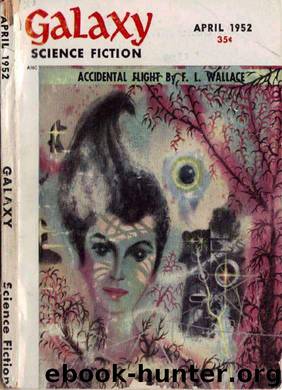Galaxy Magazine (April 1952) by Galaxy

Author:Galaxy
Language: eng
Format: mobi
Published: 1952-04-08T16:00:00+00:00
The most important result so far is the actual dating of the Ice Age. The whole Ice Age, consisting of four glaciations interrupted by much longer intergla-cial periods, is estimated to have lasted one million years, from its very beginnings to the melting of the glaciers during their last retreat. The customary figure given for the melting away of the glaciers of the last advance was 20,000 years. Since this was a figure that was still within reach of the C-14 method, some Ice Age material was tested. In Wisconsin there was a forest which had been pushed down by the glaciers of the last advance, and this was worked on.
The result sounded incredible at first: 12.000 years. This was
more recent by far than anybody had believed, especially since it marked the last advance, not the last retreat. The retreat could not be studied in Wisconsin; but in Nebraska they found an old forest which had grown up after the retreat of the last ice sheet. They gave an age of 10,500 years. Comparable material from Europe, procured in a great hurry, gave figures which differed from the Wisconsin and Nebraska result only within the expected margin of error, The overall length of the Ice Age probably was what geologists say, but the last glaciation was much closer to our time than believed. It was still going strong 12.000 years ago, but it lasted for less than 20 centuries.
THE ROBIN THAT HIT THK BOTTLE
DID you ever miss making an interesting observation just because you didn't know there was something to see? I did, and if I hadn't been behind in my reading, I might have contributed to something which is still a controversial matter. And every time I see a robin , «, .
But let me begin at the beginning, which happens to be in Australia, even though the story itself is essentially an American one. Australia is, as everybody knows, the land of strange ani-
mals. But it seems as if the Australians did not know as much of their animals as one would wish—it also seems that they "knew" a lot of things that weren't so—and a quarter-century ago the Australian publishing firm of Angus 85 Robertson decided to do a set of books on Australian Natural History, written by Australians for Australians. One of. these was about Australian birds, written by Alec H Chisholm and published in 1935.
FOR YOUR INFORMATION
I own a copy of that book, on page 153 of which there are two paragraphs reading:
Early in 1934 a boy living near Melbourne wrote to me, stating that he had seen English Starlings picking up ants in their beaks and placing them under their wings. If this had been the first report of the kind I should have doubted the evidence of the boy's eyes. However, seven years previously a Sydney man, one who had watched birds in aviaries and in the wild during many years, had asked me: "What is the reason why soft-billed birds such as starlings, jays, etc.
Download
This site does not store any files on its server. We only index and link to content provided by other sites. Please contact the content providers to delete copyright contents if any and email us, we'll remove relevant links or contents immediately.
Sita - Warrior of Mithila (Book 2 of the Ram Chandra Series) by Amish(54658)
The Crystal Crypt by Dick Philip K(36773)
Cat's cradle by Kurt Vonnegut(15187)
Always and Forever, Lara Jean by Jenny Han(14802)
Ready Player One by Cline Ernest(14527)
The Last by Hanna Jameson(10149)
Year One by Nora Roberts(9705)
Persepolis Rising by James S. A. Corey(9226)
The remains of the day by Kazuo Ishiguro(8826)
Never let me go by Kazuo Ishiguro(8714)
Red Rising by Pierce Brown(8613)
Dark Space: The Second Trilogy (Books 4-6) (Dark Space Trilogies Book 2) by Jasper T. Scott(8117)
The handmaid's tale by Margaret Atwood(7680)
The Circle by Dave Eggers(7038)
Frank Herbert's Dune Saga Collection: Books 1 - 6 by Frank Herbert(6939)
The Testaments by Margaret Atwood(6775)
Legacy by Ellery Kane(6585)
Pandemic (The Extinction Files Book 1) by A.G. Riddle(6459)
Six Wakes by Mur Lafferty(6157)
